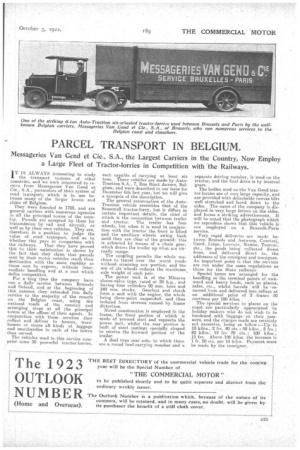PARCEL TRANSPORT IN BELGIUM.
Page 9

If you've noticed an error in this article please click here to report it so we can fix it.
Messageries Van Gend et Cie., S.A., the Largest Carriers in the Country, Now Employ a Large Fleet of Tractor-lorries in Competition with the Railways.
iT IS ALWAYS interesting to study I. the transport systems of other countries, and we were interested to receive from Messageries Van (end et Cie., S.A., particulars of their system of road transport; which is in. use between many of the larger towns and cities of Belgium.
They were founded in 1798, and are general carriers with numerous agencies in all the principal towns of the country. , Parcels are accepted by them for transmission by rail and aircraft, as well as by their own vehicles. They are, therefore, in a position to judge the value of road transport, and as to Whether this pays in comparison with the railways. That they have proved this to their satisfaction is shown by the fact that they claim that parcels sent by their motor vehicles reach their destination with the same rapidity as those sent by express, without intermediate handling and at a cost which defies competition. For a long time the company have run a daily service between Brussels and Ostend, and at the beginning of this summer they extended this daily service to the majority of the resorts on the Belgian coast, using the national roads of the country and arranging stops at. all the principal towns at the offices of their agents. In conjunction. with these services they collect and deliver to houses, warehouses or stores all kinds of luggage and merchandise in each of the towns thus served.
The vehicles used in this service comprise some 30 powerful tractor-lorries,
each capable of carrying as least six tons. These vehicles are made by AutoTraction S.A., 7, Rue Biart .Anvers, Belgium, and were described in our issue for December 6th last, year, but we will give a synopsis of the description. The general construction of the AutoTraction vehicle resembles that of the Scammell tractor-lorry, but it differs in certain important details the chief of which is the connection between trailer and tractor. The trailer has four wheels, but when it is used in conjunction with the tractor the front is lifted and the auxiliary wheels swing back until they are clear of the ground: this is achieved by means of a chain gear, which draws the trailer up what are Virtually ramps.
The coupling permits the whole machine to travel over the worst roads without straining any, portion, and the use of six wheels reduces the maximum.. axle weight of each :pair.
The power unit is of the Minerva sleeve-valve type, rated at 20 h.p., and having four cylinders 90 mm. bore and 140 tam. stroke. Gearbox and clutch form a unit with the engine, the whole being three-point suspended. and thus isolated from stresses caused by frame distortion.
Novel construction As employed in the frame, the front portion of which is made of pressed steel and supports the power unit., whilst the rear portion is built of steel castings specially shaped to receive the forward portion of the trailer.
A dual type rear axle, in which there are a round load-carrying member and a. separate driving member, is used on the tractor, and the final drive is by internal gears.
The bodies used on the Van Gend tractor-lorries are of very. large capacity, and are provided with detachable canvas tilts well stretched and laced down to the sides. The name of the company is dis• played in very large letters on the sides, and forms a striking advertisement. It will be noted that the photograph which we reproduce shows that this vehicle is one employed on a Brussels-Paris service.
Very rapid deliveries are made between Brussels and Antwerp, Courtrai, Gand, Liege, Louvain, Namur,. Tournai , etc., the goods being -collected direct from, and delivered direct to, the addresses of the consignor and consignee. An important. point is that the services are run under the same regulations as those for the State railways Special terms are arranged for the handling at the terminal points of awkward and heavy loads, such as pianos, safes, etc., whilst barrels will be -removed from and delivered into cellars at an additional price of 2 francs 50 centimes per 100 kilos.
The special services to places on the coast are particularly appreciated by holiday makers who do not wish to be burdened with luggage on their journeys, and the charges made are certainly not excessive, being as follow :—Up to 10 kilos., 2 frs. 40 cts.; 50 kilos., 8 frs.; 80 kilos., 12 frs. 20 cts. ;• 100 kilos., 15 frs. Above 100 kilos. the increase is 1 fr. 50 cis. per 10 kilos. Payment. must be made by the consignor.
































